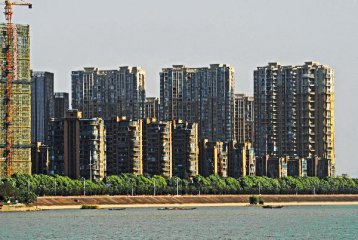
Of 70 large and medium-sized cities being surveyed, the sales price of newly-built houses in first-tier and second-tier cities saw a month-on-month growth of 0.5 percent and 1.3 percent, respectively, in October, representing a decline of 2.8 percentage points and 1.0 percentage point from September; while the sales price of second-hand houses moved up by 0.6 percent and 0.8 percent month on month, respectively, a drop of 2.9 percentage points and 1.1 percentage points from previous month. Apparently, the housing market in first-tier cities and second-tier cities has cooled down and the month-on-month growth of housing price rapidly drops, according to the National Bureau of Statistics (NBS).
Industry insiders pointed out that regulation measures targeting at real estate market were launched nationwide around the National Holiday, interrupting the one-year-long rapid surge of housing price. But noticeably, the structure of “declined trading volume and stagnant price” might continue in the market when capital is not completely tightened up.
Transaction in real estate market sees month-on-month decline
Driving by booming market earlier, the sales of houses during January-October period hit 9,148.2 billion yuan, growing by 41.2 percent from a year earlier and higher than 8,728.1 billion yuan recorded in the full year of 2015. Meanwhile, 1,203.38 million square meters floor area were sold, a year-on-year growth of 26.8 percent and the highest record in the same period of previous years.
But in October alone, the transaction of the real estate market experienced rapid decline. Data from Centaline Property Research Center shows that as of Oct. 30, 270,164 houses were sold in 54 cities across the country in October, dropping below 300,000 houses in nearly three months and a drop of 15 percent from September. Meanwhile, the subscription rate at the opening for sales of new houses has largely dropped to 64 percent in major cities in October, a month-on-month drop of 14 percentage points and almost the lowest since April this year.
Report from property research agency E-House China R&D Institute shows that in October, 22.23 million square meters floor area of newly-built houses were transacted in 30 typical cities surveyed by E-House, a month on month drop of 8.0 percent.
To be more specific, in October, 3.48 million square meters floor area of newly-built houses in four first-tier cities were sold, a month-on-month decline of 3.3 percent and year-on-year decline of 0.8 percent. As to second-tier cities, 15 million square meters floor area of newly-built houses were transacted in 15 second-tier cities, a month-on-month decline of 13.8 percent and a year-on-year growth of 7.8 percent. 9 second-tier cities experienced month-on-month drop with Suzhou city, Fuzhou city and Nanjing city ranking top in terms of range.
Yan Yuejin, research director of a think tank at the E-House China R&D Institute, indicated that transaction in October dropped a little from the figure recorded in September, showing the effectiveness of policy control. Under further tightened restrictive policies over purchasing and loans, the threshold for purchasing houses in hot cities is lifted and the demand for speculating houses is reduced,
Yan also believed that as policies further play their role, it is expected that the floor areas transacted in hot cities will possibly further decline and the range of housing price hike will also be narrowed, then market will tend to stabilize.
Downward pressure hard to reverse shortly
Noticeably, data also suggests that though transaction declined in the real estate market in October, the floor areas of newly-built houses transacted in 30 cities in October 2016 grew by 19.2 percent, 139 percent, 45.5 percent, 23.8 percent, 23.8 percent and 11.2 percent, respectively, when compared with the same period during 2010-2015. It means that the transaction in October 2016 is the highest in the same period of nearly 7 years.
As to housing price, data from the NBS also shows that some cities still see high rise in housing price with 7 cities seeing a housing price hike over 3 percent. As to month-on-month growth, Wuxi, Changsha, Zhengzhou, Jinan, Hangzhou, Ganzhou and Wuhan hiked 4.9 percent, 4.5 percent, 3.5 percent, 3.4 percent, 3.2 percent, 3.1 percent and 3 percent.
Yang Kewei, researcher with CRIC Research Center, indicated that supported by great amount of housing loans, it is still too early to tell that the market has rapidly “cooled down” in some cities. The structure of “declined trading volume and stagnant price” might continue in the market when capital is not completely tightened up.
The October Financial Statistics Report released by the People’s Bank of China (PBOC) shows that 651.3 billion yuan were added to RMB loans, a year-on-year growth of 137.7 billion yuan, while 433.1 yuan were added to the loans provided by housing authorities, accounting for 66.5 percent.
It is worth noting that real estate companies are not financially strained now while housing loans see relatively abundant supply. Without pressure from sales, housing developers are quite reluctant to lower price. Data from Centaline Property Research Center shows that up to now, the sales of 23 real estate developers in the first 10 months aggregate 1.73 trillion yuan, a year-on-year growth of 81 percent. Their annual tasks are nearly completed.
Industry insiders believed that against such backdrop, low supply and low investment of real estate developers should be alerted. Yang remarked that current pickup in the investment growth is a result of low base in last year. Investment in real estate area recorded negative year-on-year growth for five consecutive months during the August-December period 2015. But high growth cannot hide the fact that the industry is experiencing adjustment. It is a definite fact that due to tightened policies and standardized market, real estate developers are not willing for development and investment.
Therefore, in the future, housing loans should be controlled to reduce demand for speculation; housing companies should be stimulated to increase house supply. Yang pointed out that China’s central bank also proposed in its Q3 report that “financial risks should be prevented while curbing asset bubbles”. It means that the total housing loans stay high now, further measures, especially those targeting at hot cities, will be taken.
Zhang Dawei, market director of Centaline Property, also indicated that the 18-month-long boom of the real estate market starting from March 2015 is driven by capital. And the wave is ebbing from October 2016 and following market trend is still decided by capital price and policy changes. It is expected that the regulation will last for at least 6-9 months and by then housing price will be forced to decline.
Translated by Jennifer
























Latest comments